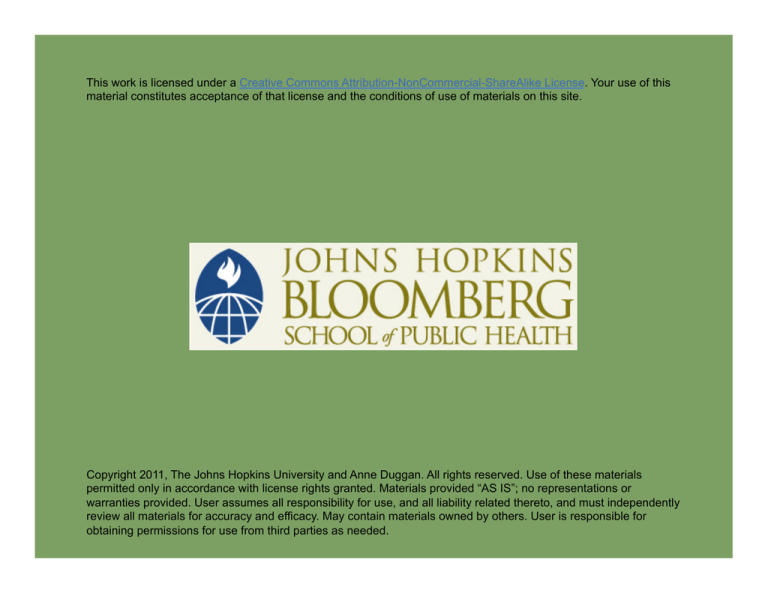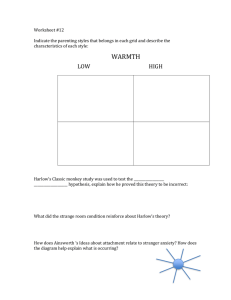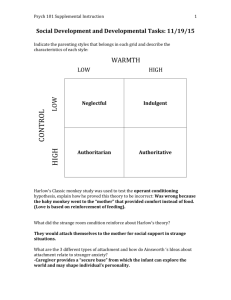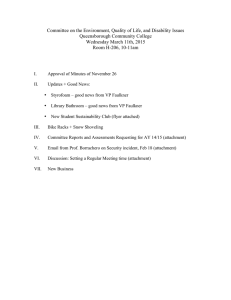
This work is licensed under a Creative Commons Attribution-NonCommercial-ShareAlike License. Your use of this
material constitutes acceptance of that license and the conditions of use of materials on this site.
Copyright 2011, The Johns Hopkins University and Anne Duggan. All rights reserved. Use of these materials
permitted only in accordance with license rights granted. Materials provided “AS IS”; no representations or
warranties provided. User assumes all responsibility for use, and all liability related thereto, and must independently
review all materials for accuracy and efficacy. May contain materials owned by others. User is responsible for
obtaining permissions for use from third parties as needed.
Section B
Adult Attachment Outcomes and Interventions
Measuring Adult Attachment: Two Basic Approaches
Developmental psychology
- Interview
- Attachment “state of mind”
- Example = Mary Main’s Adult Attachment Interview
Social psychology
- Self-report scales
- Attachment “style”
- Example = Feeney and Noller’s Attachment Style Questionnaire
3
Intergenerational Transmission
Early childhood tasks and social fields
Attachment theory basics
Measurement of attachment
Intergenerational transmission
4
Intergenerational Transmission of Attachment Status
Mother per adult
attachment interview
Child per Strange
Situation procedure
Secure/autonomous Secure
Dismissing Avoidant
Insecure
Preoccupied Resistant/ambivalent
Unresolved Disorganized
5
Outcomes
Early childhood tasks and social fields
Attachment theory basics
Measurement of attachment
Intergenerational transmission
Outcomes
6
Association of Attachment with Later Development
Low-risk samples
- Weak associations, but small studies
High-risk samples
- Preschool, elementary school
Early insecure attachment poor peer relations,
moodiness, depressive symptoms, aggression
- Adolescence
Anxiety disorders, dissociative disorders
7
Association of Attachment w/Psychopathology in Adulthood
Mostly case-control and cross-sectional studies
Depression, anxiety disorder, borderline personality disorder
- 3-way classification
Preoccupied at greatest risk
- 4-way classification
Unresolved/disorganized at greatest risk
8
Approaches to Intervention
Early childhood tasks and social fields
Attachment theory basics
Measurement of attachment
Intergenerational transmission
Outcomes
Approaches to intervention
9
Conceptual Framework—Determinants of Parenting
10
Conceptual Framework—Determinants of Parenting
11
Intervene Early
Intervene early because early parenting tracks into grade school
AOR*
p
Nonviolent discipline
4.5
<.01
Psychological aggression
5.9
<.01
Severe assault
7.6
<.01
Neglectful behavior
3.7
<.01
Confirmed CPS report
6.7
<.01
*AOR for later use if tactic used birth–3 years
12
Video-Based Parent Training in Well Child Visits
Design: RCT; assignment by family
Setting: inner city public hospital clinic
Sample: Latino mother-newborn dyads
- Inclusion criterion: low maternal education
- Exclusion criteria: prematurity, medical complication,
psychosocial issue, no VCR at home
Measures:
- Cognitive development: Bayley MDI
- Language development: PLS-3
- EI eligibility: <2 SDs below mean on 1 scale
<1.5 SDs on both scales
Source: Mendelsohn, A.L. et al. (Feb. 2005). Developmental & Behavioral Pediatrics, 26(1), 34-41.
13
VIP Study—Definition of Conditions
Control = usual care per AAP guidelines
Experimental = usual care per AAP guidelines
plus
12 sessions with child development specialist
2 weeks – 3 years old, about 45 minutes each visit
Curriculum for cognitive, language, SE development
-
Three parts to each session
1. Discuss parent expectations and concerns
2. Give developmentally stimulating book or toy
3. Videotape 5- to 10-minute parent-child interaction;
review; focus on strengths, activities to do at home; copy
for family
14
Control vs. VIP Group Outcomes
Mothers completing 7th-11th grade: substantial impact
Mothers completing <7th grade: smaller effects
15
Conceptual Framework—Determinants of Parenting
16
COS Protocol—Principles
1. Lasting change results from parents developing specific
relationship capacities vs. learning parenting techniques
- Understanding children’s relationship needs
- Observational and inferential skills
- Reflective functioning
- Emotional regulation
- Empathy
2. Capacities are best enhanced within a secure-base relationship
3. Interventions are most effective if they focus on the strengths and
struggles of each dyad
17
COS Protocol
Weeks
Content
1-2
Introduce attachment theory and COS graphic
3-8
Observe Strange Situation video clips; note successes
9
Build framework to look at defensive processes
10-15
View new video clips; focus on under-developed capacities
16-20
View new video clips; celebrate positive change; make a plan
for future
18
COS Early Head Start Study: Attachment Status
Results—COS Early Head Start Study
pre/post improvement in attachment status (p<.001)
19
Conceptual Framework—Determinants of Parenting
20
Breaking Negative Cycles of Ineffective Parenting
Breaking negative intergenerational cycles of ineffective parenting
- Hypothesis:
Five competing theoretical models of adult attachment as
an influence on parenting
- Design:
Cohort study, 10-27 months old
- Sample:
Mother-firstborn son dyads
- Measurement:
Maternal attachment status: AAI at 11 mos
Parenting: 180 mins observation at 27 mos
Stress: Parenting Daily Hassle
Source: Phelps, J.L., Belsky, J., & Crnic, K. (1998). Earned security, daily stress, and parenting: Comparison of five
alternative models. Development and Psychopathogy, 10, 21-38.
21
Maternal Attachment Status and Level of Stress
Positive parenting score by
maternal attachment status and level of stress
22
Home Visiting: A Comprehensive Approach
Home visiting is a comprehensive approach to parent training
23
Home Visiting: A Comprehensive Approach
Home visiting is a comprehensive approach to parent training
24
Participant Responsiveness
Participant responsiveness influences HV fidelity and impact
25
Participant Responsiveness
Participant responsiveness—varying response to creative outreach
26
Participant Responsiveness
Participant responsiveness—varying identification of poor mental health
27
Home Visiting Need and Impact
Differential home visiting need and impact—highest in mothers with relationship anxiety
28
Home Visiting Need and Impact
Differential home visiting need and impact—highest in mothers with relationship anxiety
29
Recap of Points
Early childhood is a crucial time; parents are a key influence
Early experiences with attachment figures have long-term
consequences
Parenting interventions should explicitly consider caregivers’
attachment status
30




